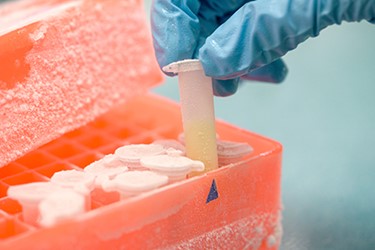Large Volume Cryopreservation – A Liquid Nitrogen Free Proof-Of-Concept Study

Large-volume cryopreservation
The controlled cooling of small sample volumes is common in many scientific cryopreservation applications. The ability to cryopreserve larger volumes, for example in the development and production of many late-phase gene and cell therapies, is becoming increasingly desirable as more licensed treatments become available.
CAR T cell therapies, as well as blood products and cord blood, are some common examples of where large-volume cryopreservation is common. This is due to the large cell numbers required for effective treatment, as well as processing limitations. In all applications, it is critical that cell viability and function are maintained during the cryogenic processing and after thawing.
In many cases, liquid nitrogen (LN2) is the default choice for cryopreservation, pumped into the cooling chamber directly. Use of LN2 can give rise to concerns of contamination and sterility, safety, and additional running costs. Samples nearest to the LN2 source will also cool at a different rate than those furthest away, leading to inconsistent cooling and concerns regarding cell viability.
This study demonstrates a cell freezing protocol that uses the LN2-free VIA Freeze Quad controlled-rate freezer for the cryopreservation of up to eight cryobags and up to 560 mL total volume. Similar protocols can be applied to the VIA Freeze and VIA Freeze Duo controlled-rate freezers for cryopreservation of up to 140 mL and 280 mL, respectively.
Using this VIA Freeze protocol, thermal profiles and biological outcome in terms of post-thaw viability are equal between different bags in a “rack” set-up and unaffected by the orientation of the cryobags (vertical or horizontal). Also, the same cooling rates and biological results are achieved whether cryopreserving only one bag, or eight, indicating that the proportion of loading capacity used does not impact VIA Freeze performance.
Get unlimited access to:
Enter your credentials below to log in. Not yet a member of Drug Discovery Online? Subscribe today.
